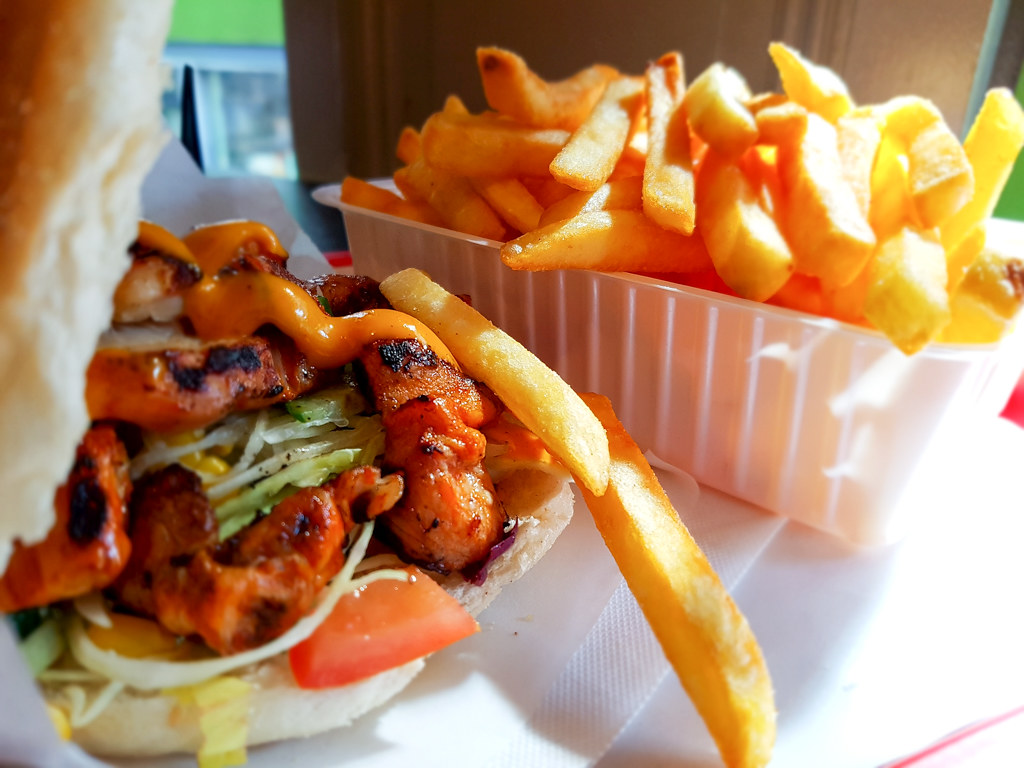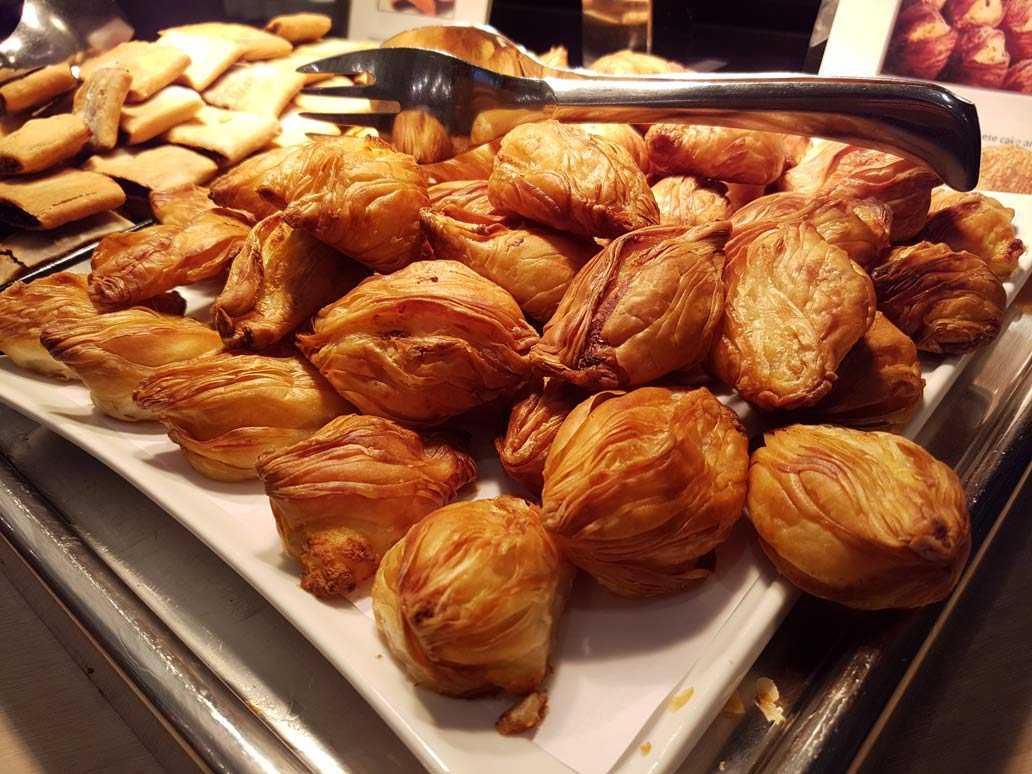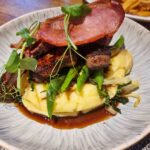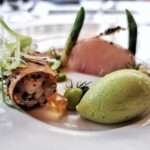During my trip to Namur I tried to experience as much as I could of the local cuisine. I didn’t know much about Belgian food, other than what the country is famous for: fries and chocolate. So I went on a quest to discover the best dishes Namur has to offer.
Prepare your trip to Namur with the Lonely Planet guides:
[showad block=13]

Cheese on bread and local beer at Maredsous
Technically not in Namur but about half an hour’s drive away, you will find the beautiful Maredsouos Abbey, famous not only for its spectacular building and its school or arts but also for its cheese production.
The monks from Maredsous have been producing cheese since 1953, maturing it for 22 days in the cellars of the abbey, where the temperature is a constant of 12 degrees. Every two days, each piece of cheese is washed in brine by hand, starting from the oldest to the youngest, so that the typical microbiotic flora transfers from one to another and create the orange crust and its aroma. The cheese at Maredsous is made out of cow’s milk and not until long ago you could actually visit the production section. However, since the production has been industrialised, for healthy reasons the access to the public is now forbidden.
Maredsous also serves its own beer in cute personalised ceramic mugs. Even if the abbey doesn’t have a brewery within its walls anymore, the Maredsous beer is being brewed under licence by Duvel Moorgat, following a centuries old recipe of the original Benedictine beers. A large proportion of the revenues of the Maredsous beer go back to charity, as the Benedictine philosophy stands for.
There are three types of beer under the name of Maredsous: the Blond (6% abv), the Brune (8% abv) and the Tripel (10% abv). They all share the same process of brewing, re-fermenting in the bottle with a fruity but dry taste.

When you visit the Maredsous Abbey you have to stop at their café situated in an impressive neo-gothic hall and have a mug of beer and cheese on bread. It’s a simple, humble meal, but the flavours combine so well together. The rich creamy cheese melts in your mouth while the beer washes it down. I tried the Tripel beer and while it tasted fruity and refreshing at the beginning, it left a warming aftertaste with hints of caramel.
Frites
There is an entire dispute on which country has first invented the frites (fries), Belgium or France. I can’t answer that question but I can tell you that there are references that Namur’s inhabitants were making fried potatoes as early as the 1680s. Probably one of the most famous dishes in the world, the fries seem to have originated here, in the Meuse valley, when the river froze in winter and the locals started to fry potatoes instead of the fish.
Today you can enjoy the crispy on the outside and soft on the inside frites with a large range of different sauces. My favorite sauce is Brazil, a mayo, pineapple and curry combination. The names of the sauces really have no connection to the countries or regions they are named after. For example, the Andalouse sauce tastes similar to thousand islands dressing, the Samurai sauce is a combination of mayo with tomatoes and chilli, while the American sauce is made out of mayo, tomatoes, capers, onions and celery. See, nothing to do with the countries they are names after. 🙂

I found the best frites in Namur to be actually across the bridge, in Jambes, at Friterie Raphael. It was the evening of Easter Day and only a few restaurants were opened for dinner in town. I knew I couldn’t leave Namur without having frites so I decided that this was going to be my festive meal. When I arrived at Friterie Raphael, a hole in the wall on the main street, I found it full. The queue of people was so big that they were waiting outside of the place as well (the inside is very small). I had no cash on me and they wouldn’t take cards so by the time I found and ATM and returned, I could squeeze inside, behind the last man in the queue. Oh yes, the queue was formed only of men.
I didn’t wait for long though before my turn came. To order, I had to remember the French I’ve learned in school, almost 20 years ago, as nobody spoke English. The funnies moment was when I tried to ask for a bottle of water as well and instead of the beautiful French word “eau” I managed to pronounce a terrible “ou” that made everybody laugh. This place is definitely not a touristy spot and I could tell by how delicious the fries were, served in a paper cone, with salt on top and my sweet Brazil sauce on the side. The price of a portion of frites is between 2.2 and 2.8 euros, depending on the size of the cone.
Mitraillette
If you are really hungry, when you go to the friterie you can order the Mitraillette, a huge sandwich consisting of half a baguette filled with meat, fries, salad, cheese, cabbage and a variety of sauces on top. The mitraillette (translated as the “submachine gun”) has originated in Brussels but it is very popular in Wallonia as well, especially among students.
If you think about it, the name may come from how loaded the baguette is. If you are on a diet, keep away from the mitraillette, it probably contains the full amount of daily calories recommended, maybe even more. But it is so delicious and flavoursome.

I had a version of the mitraillette, with the fries on the side, in a friterie in the centre of Namur just off the Place d’Armes, while chatting with my new Syrian friend (story coming soon). Each friterie has its own version of the mitraillette, with the meat varying from steaks, to sausages, to meatballs, to hamburgers, to chicken. At the friterie where I had it, I had a choice of what meat and what vegetables I wanted in my sandwich. The price of a mitraillette is between 6 and 8 euros, depending on the type of meat it has in it.
Stoemp aux carottes (or djoute)
Stoemp is a simple, rural dish, made out of mashed potatoes combined with carrots and other root vegetables like sprouts, turnips, leeks, onions. It is usually mixed with bacon, sausage or minced meat, and sometimes even eggs. You could say that stoemp is a type of Belgian comfort food, hearty and warming if eaten on a cold winter day.

Stoemp is similar with the English bubble and squeak or the Irish colcannon, both comfort foods for bad weather.
I tried stoemp at the little café from the Citadel of Namur, accompanied by a glass of Houppe, a soft citrusy blonde beer locally made by L’Echasse – Brassierie Artisanale de Namur, a local brewery.

Quiche and Vi Keute beer
Quiche is an open tart with a pastry crust filled with eggs, milk, cheese and different other ingredients, originated in France. The original version is called Quiche Lorraine and incorporates eggs and bacon.
Quiche is well spread around Europe and there are many variants of it, including a wide range of ingredients, from simple cheese, tomatoes or spinach to seafood and meat.
I went for a goats cheese and broccoli quiche, which was really good (I know, I am one of those weird people who love goats cheese). I really enjoyed the softness of the filling combined with the crunch of the crust.

Vi Keute beer is produced especially for La Maison des Dessert and it is blonde, with an alcohol content of 7,5%. It tastes malty but fresh, with hints of spices in the aftertaste. It is a beer that goes under fermentation twice: once in the brewery and once in the bottle. You will recognise the beers that ferments for a second time in the bottle by the traces of yeast left at the bottom of the glass.
It was the perfect beer to accompany the quiche.
Beef tartare
This dish might not be everyone’s cup of tea and it originates from France. I really wanted to try it when I visited Cherbourg but I didn’t get a chance back then so when the opportunity arose in Namur, I’ve had to have it.
Beef tartare is practically very high quality fresh raw sirloin mixed with an egg yolk, onions, capers and different herbs.

I have first tried the steak tartare when a friend of mine cooked it for me, years ago. At first I was very hesitant and I refused to eat it but once I tried a little bit I realised how delicious it was. I even asked for a second plate back then.
You can have the beef tartare either with the ingredients on the side or already mixed together. I chose the second version and enjoyed every single mouthful. It is very hard to describe how all the ingredients blend in together transforming the raw meat into a delicacy, making it taste so good.
I had this dish at the Fenetre sur cour restaurant, an opulent place with large chandeliers hanging from the high ceilings and a beautiful veranda with panoramic windows.

Moelleux au chocolat
At the same restaurant, Fenetre sur cour, I tasted the moelleux au chocolat, a decadent dessert with a warm liquid centre. We can all agree that Belgium is one of the best chocolate producers in the world, with rules that impose a minimum of 35% pure cocoa standard in each piece. Many companies in Belgium produce the chocolate by hand and follow strict traditional recipes.

I encourage you to eat as much chocolate as you can while in Belgium but don’t stick only to pralines. Try the delicious moelleux au chocolate as well, or as we call it, the chocolate lava cake.
This delicious dessert looks so fancy but in fact it only has five ingredients: butter, eggs, flour, sugar and chocolate. It has a very rich taste which on my plate was tamed with the slightly citrusy flavour of fresh raspberries.
Bietrume de Namur
Remember when I told you that Namur is a slow city? This is exactly how you should eat the traditional sweet of the town, the Bietrume de Namur, a large soft caramel made out of fresh milk cream and toasted hazelnuts. It is not easy to chew but the taste is really nice, of butter and chocolate. It melts quite easily in your mouth and it does not stick to your teeth, as other caramel candies do.

The Bietrume de Namur was created in 1954 by a Namurese confectioner and named after an 18th century farce of the town, Bietrume Picard. He is now depicted on the wrapping of the candy.
The best place to buy the Bietrume de Namur is La Maison des Dessert, a premium patisserie (and chocolaterie) with an elegant café in the back.
Belgian wine with local charcuterie selection
Did you know that Belgium makes its own wine? You wouldn’t think of that, after all Belgium is known for its beer not for wine.

Belgium has a modest wine production divided into two regions, one in Flanders and one in Wallonia. While the wine from the first region is simply called Flanders wine, the Wallonian part has quite the bohemian name, “Vin de pays des Jardins de Wallonie” (wine from the Country of the Wallonia gardens).
I have tasted the Belgium wine, accompanied by a board of local charcuterie at Vino Vino, a tiny wine bar in the old centre of Namur. Their menu is written on a blackboard, just above the bar (and the big leg of jamon sitting on it). The man who served us was very friendly, knowledgeable and knew so much about wine and what to recommend. In fact, he was so nice that at the end of the evening he run after us on the street to say good-bye and thank you, because he missed us when we left.

The Belgian wine I tried was a red blend of Pinot Noir (70%) and Cabernet Sauvignon (30%) from the Chenoy Domains, and it wasn’t disappointing at all. The aroma was unique, with hints of chicory and surprisingly, subtle notes of green peppers.
Go to the market!
If you are lucky to be in Namur when there’s a festival in town (and there are plenty), don’t hesitate to go to the market and try some of the home-made goodies the locals are selling. I visited Namur during Folknam, one of the biggest annual folklore festivals, when the entire Place d’Armes was occupied by knights and cavaliers, by people dressed up in traditional costumes but also by small local producers with their macarons, sausages or liquors.



This post has been written with the support of the Namur Touristic Office and the Citadel of Namur.
Some of the links on this website are “affiliate links.” This means that if you click on the link and do a purchase, I will receive an affiliate commission at no extra cost for you. This helps me keep my website running and continue to share my traveling knowledge with you. I thank you for booking your flights or hotels using the links on my website. Regardless, I only recommend products or services I use personally and believe will add value to my readers.





The selection in Namur is off the shelves! So much delicious food. I will go to the market. That is for sure. I know my husband will go for the beef tartare. He had a version of it in Prague but he is looking forward to try it again.
Oh my god all of this looks so good. As i studied 3 years in Belgium I got to know well the Belgian cuisine. I guess my absolute favourites are the tartare and moelleux au chocolat. Nothing better. I have to try the ones from Namur now 🙂